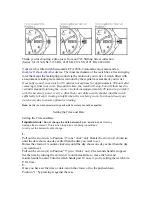
2 Once successfully connected, the measurement
results are synced to the Philips
HealthSuite health app. If the sync is successful,
the measurement results are displayed in
the Philips HealthSuite health app, where you
can check your personal health data.
Note: Some health parameters, like resting heart
rate, take up to 24 hours to start displaying data.
Note: If you are unable to sync, see chapter
'Troubleshooting' for more information.
Firmware update: The app notifies you when new
firmware of the health band is available and will
ask you if you want to update it.
Charging
The health band has a built-in rechargeable
battery. Only use the charger supplied to charge
the battery.
Note: The Philips health band does not have a
power button. When the device is charged, it is
always on unless the battery is empty. When the
battery is empty, the battery fully charges in
approximately 90 minutes.
1
Place the health band in the charger (Fig. 2).
Note: Make sure that the health band connects
to the charger properly.
2 Plug the USB cable in a USB port of a
compatible charger, such as a computer or an
adapter. The display will show the battery is
charging.
3 When the battery is fully charged, the health
band briefly displays full battery status icon.
Double tap on the display of the health band to
wake it up and see the battery display.
Tip: Charge your health band when you are not
active, e.g. during a meal.
Remove the health band from the charger
To remove the health band from the charger follow
these steps.
1
Hold the strap of the health band between your
thumb and finger.
2 Push down with your thumb on the health band
release tab on the side of the charger to release
the health band from the charger (Fig. 3).
Note: Do not pull the USB cable of the charger
while removing the device.
Battery status
Battery is almost empty and requires
charging
Battery is fully charged
You can see the current battery status when you
look at the time.
Fully charged batteries can last for approximately
three days. When the battery is almost empty and
requires charging, the battery icon is shown on the
display. When the battery is empty, the display
turns off and no further data will be stored.
Wearing the health band
Always wear the Philips health band on the
outside of your wrist (Fig. 4
,
Fig. 5), in direct
contact
with your skin (Fig. 6). Make sure that the
health
band is not on your wrist bone (Fig. 7). The
health
band is designed to be worn day and night.
Note: You can wear the health band on your left or
right wrist. In the app you can also set which hand
is your dominant hand. Make sure the wearing side
in the settings menu of the HealthSuite health app
is the same as the wearing side on your wrist. If
you wear the health band on your other wrist, also
change the wearing side in the app to ensure
correct health metrics.
Avoiding skin reactions
To reduce the risk of skin reactions follow these
instructions.
- Clean the device and skin underneath the
device regularly and after each sports session.
Take the health band off once in a while to give
your skin some rest.
- Always dry the device when it has become wet.
- Do not wear the strap too tight, to ensure it is
still comfortable to wear.
Wearing the health band comfortably
- Wearing clothes over your health band could
cause the health band to slide across the skin
slightly. This might feel uncomfortable.
- At any point during the day or after exercising
your wrist may be swollen, this is a natural
effect.
- If you feel any discomfort due to the straps,
give your skin some rest by not wearing the
health band for a short period of time or by
wearing the health band on your other wrist.
When you refasten the health band, try
loosening the strap a notch.
Wearing the health band correctly
Wearing the health band correctly will positively
influence the accuracy of the measurements.
Accurate measurements rely on three key factors:
- The sensor should be in direct contact with the
skin. Make sure that the health band is
positioned correctly and not worn too loose
(ensure a snug but comfortable fit). Make sure
the health band and your wrist are clean and
do not have moisture and dirt on them. When
skin contact is lost due to a lot of hand/wrist
movement, you can try re-positioning the
health band at bit higher up on the arm or on
the other arm.
- The health band should be able to transmit
light through the skin. For example, tattoos in
the wrist area might cause inaccurate
measurements, because less light is transmitted
through the skin. Try re-positioning the health
band to a place where you do not have tattoos,
e.g. higher up on your wrist or wear it on your
other wrist.
- There should be sufficient blood flow through
the skin for an accurate measurement.






























